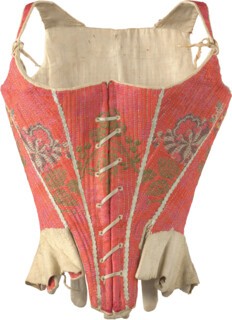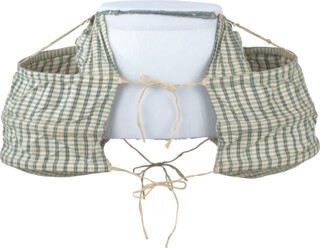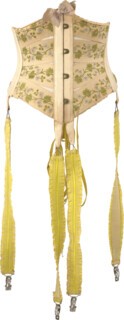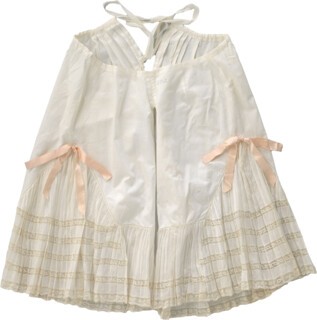Novelists like to snoop inside their characters’ underwear drawers. In Sylvia Townsend Warner’s Lolly Willowes (1926), Laura, the heroine, finds her sister-in-law Caroline difficult to read, except in one telling aspect:
Once only did she speak her spiritual mind to Laura. Laura was nursing her when she had influenza; Caroline wished to put on a clean nightdress, and Laura, opening the third drawer of the large mahogany wardrobe, had commented upon the beautiful orderliness with which Caroline’s body linen was arranged therein. ‘We have our example,’ said Caroline. ‘The graveclothes were folded in the tomb.’
This would be enough to make anyone uneasy. Caroline’s ‘large shadowy drawer’, like Christ’s empty tomb, is a place of ‘revelation’: in her pure white ‘nightgowns and chemises’, ‘folded exactly upon each other’, Laura gets a sudden, alarming glimpse of her sister-in-law’s ‘private thoughts’. It makes her ‘shudder a little’. The question of the ‘body linen’ is a practical one – Caroline is unwell with a fever, she wants a fresh nightdress – but it comes laden with spiritual meaning. Things not ordinarily spoken of in polite company turn out to have a surprising connection to the higher mysteries.
Underwear has useful, basic functions. It protects bodies from being chafed or scarred by rough outer clothing: knights in armour wore baggy shorts under their chainmail as early as the 12th century. It also protects clothing from the body, covering the genitalia and disguising ‘signs of arousal, incontinence and menstruation’, as Nina Edwards writes in The Virtues of Underwear (Reaktion, £20). Because of its proximity to intimate areas, sites of shame or transgression, it comes with heavy cultural baggage. In Chaucer’s ‘The Pardoner’s Tale’, the sight of the Pardoner’s trousers is enough to make the Host suspicious of his holy motives: ‘Thou woldest make me kisse thyn olde breech,/And swere it were a relyk of a seint,/Though it were with thy fundement depeint!’
In Under/Wear, an exhibition at the Rijksmuseum of Dutch garments dating from the 1640s to the 1940s (until 23 March 2025), functionality competes with the claims of sexuality, morality and fashion. Pairs of late 19th and early 20th-century women’s drawers, fabricated in fine, near transparent white linen, feature ruffled bottoms, lacework edging, ribbon embellishments and in one case initials embroidered in pale blue. For practical reasons, they are crotchless, constructed of two separate baggy trouser legs held together by a thin waistband tied with a string. At the back, they swing open. As late as the 1910s, the heavy layers of structured and unstructured petticoats that women wore made drawers that you had to remove unfeasible. The ‘free-trader’ style, as it was known in Victorian Britain, allowed wearers to relieve themselves without having to wrestle with their skirts.
For a long time, women didn’t bother with underwear. During the 17th and early 18th centuries, it was considered unfeminine and transgressive to wear breeches or any other ‘bifurcated’ garments, which were the domain of men. (An exception seems to have been made for riding: an inventory of the clothing that Princess Anne, George II’s daughter, brought with her on a visit to Ham House in the 1730s lists six pairs of drawers along with her riding habit.) Instead, long cotton or linen chemises served as the primary underwear. Quilted petticoats and brocade skirts kept the lower half of the body warm – the thick, embroidered 18th-century underskirts in the Rijksmuseum look built to survive a Dutch winter – and the heavy fabric meant that skirts did not billow up. Menstruating women used rags held in place by knots or hooks, or bled freely. Underwear only became a problem at the end of the 18th century. Among the fashionable upper classes, the neoclassical taste for draped, Grecian dresses in pale-coloured, light fabrics (little more than elaborate nightgowns) made warm drawers underneath a necessity. The first women’s ‘pantaloons’ – versions of the breeches that Regency men wore – were nude-coloured and reached to below the knee, sometimes to the ankle; from the 1820s, they were increasingly replaced by more ‘feminine’ drawers in white cotton or linen. By the end of the 19th century, only the poorest women went without them.
Corseting has a much longer history. One of the objects excavated at Knossos by Arthur Evans’s team was a Minoan snake goddess figurine (c.1600 BC) sporting a thick, corset-like belt around her tiny waist. An illumination in the Winchester Psalter (c.1121-61) shows Christ being tempted by the Devil in rather sexy contemporary women’s clothing: his scaly flesh is hidden beneath a skirt and long-sleeved bodice, laced up suggestively at the front. Satan’s ‘waist is most charmingly slender, and its shape admirably preserved by tight lacing from the waist upwards,’ one Victorian dress historian commented. During the early modern period, a chest-flattening corset, known as a ‘pair of bodies’, was popular among elite women (Elizabeth I’s funeral effigy in 1603 wore bodies in fustian and leather); in the 18th century, stiff, whalebone-based stays were introduced, designed to shrink the waist and elevate the bosom. The Rijksmuseum has a rigid-looking example in scarlet embroidered linen (c.1740-60), a conical structure with built-in shoulder straps and a waist circumference that looks smaller than twenty inches.
By the mid-17th century, even small children were laced. In Velázquez’s Las Meninas (1656), the five-year-old Infanta Margaret Theresa, daughter of Philip IV of Spain, has a precociously manipulated figure, her little torso moulded into a triangle above the ballooning shape of her tiered skirt. Promoters of female dress reform (‘healthful underdressing’) in the 19th century stressed the disastrous effects of tight corseting on young bodies. In 1882 the Boston dressmaker Olivia Flynt described the typical parental attitude:
We express regret that they have placed corsets upon their daughters, and they reply: ‘Dear me, the child is larger than I was when I married, and really larger than I am now; I cannot have her grow so large, and thought you would give her something to shape her up.’ When we refuse, and ask them why they do not give her some deadly poison each day that may not prove more destructive, they, of course, think us demented.
One dreadful mother, Flynt wrote, insisted that her daughter’s waist ‘must not measure over eighteen inches’ for her coming-out party and used French corsets to shrink her. The consequences were dire. ‘One year from the night she entered society’ she ‘was married and went abroad; in less than another year her corpse was returned to her mother. She could not survive motherhood.’ The artist Gwen Raverat, a teenager during the 1890s, recalled secretly removing her whalebone stays (‘real instruments of torture’), then being discovered ‘in my soft-shelled condition’ and ‘forcibly recorseted’. Her sister, Margaret, put into them for the first time at thirteen, ‘ran round and round the nursery screaming with rage’. Their Aunt Etty, one of Charles Darwin’s daughters, feared for their internal organs. ‘She used to tell us a dreadful moral tale about a lady who laced herself so hard that she cut her liver right in half.’
Structural transformations of the figure weren’t limited to the upper half of the body. In the early 18th century there was a vogue for gigantic skirts, which had to be supported by rectangular hooped petticoats known as ‘panniers’ (after the French for ‘basket’, since they looked like floating baskets around the waist). Panniers could extend the width of a skirt to a couple of feet at each side; they made climbing stairs, getting through doorways and sitting in armchairs difficult (you had to sit with your skirts bunched up almost to your ears, ‘like a swan with her head between her lifted wings’, as the Gentleman’s Magazine put it in 1750). The Rijksmuseum has two examples from the period – one a wide, oblong frame with a small opening for the waist, upholstered in blue and white stripes; the other, in a cheery gingham print, constructed of two semi-circular frames resembling hampers, held together by ties and designed to sit on the hips. In 18th-century Britain, commentators seized on the fashion as evidence of society’s moral decline. ‘Of late, within these Two Twelve-months, or thereabout, [the pannier] has spread itself to so enormous a Circumference, that there is no enduring it any longer,’ declared ‘A.W.’, author of a pamphlet entitled The Enormous Abomination of the Hoop-Petticoat (1745). Panniers made women objectionable in all social scenarios, A.W. explained:
1st, As merely Hoop’d.
2dly, As Hoop’d, and coming into a Room.
3dly, As Hoop’d, and actually in a Room.
4thly, As Hoop’d, and in a Coach, or Chair.
5thly, As Hoop’d, and in any publick Assembly, particularly at Church.
The last was the worst. How were men supposed to go to church in the innocent desire to ‘serve GOD’, if they found themselves ‘excluded from the Pews by these Heathenish Hoops’? ‘We can neither kneel, sit, nor stand, with any tolerable Convenience, for a parcel of worthless Flirts.’
Giant silhouettes returned a century later and provoked similar outrage. In 1856 the first cage crinolines were manufactured in France, hooped steel frames with wide circumferences that were strong enough to support voluminous, bell-shaped skirts. Much was made of the dangers that the largest and most cumbersome presented. Florence Nightingale, who loathed them, claimed that in 1863 and 1864 alone, 277 women had burned to death as a result of their crinolines catching fire. A contemporary Dutch cartoon strip, Het Nut eener Crinoline (‘The usefulness of a crinoline’), conjures up a series of absurd countryside scrapes involving a fashionably crinolined woman and various bemused animals: a charging goat gets tangled up in the crinoline frame, tearing it from under her skirts; a stork spies it from above and carries it off to make a nest. In the 1870s, bustles (or ‘dress-improvers’) arrived on the scene, steel frames that jutted out exaggeratedly at the back to create posterior-focused silhouettes. A tubular bustle in the Rijksmuseum (c.1880-84), constructed of half-hoops sewn into striped cotton, was designed to make the wearer’s skirt flow over it like a waterfall; another example features a black padded cushion to create volume, Kardashian-style. Some bustles were feats of engineering. The collapsible ‘New Phantom’ design (1887-88), patented by the London clothiers Stapley and Smith, folded neatly like an accordion when the wearer sat down.
By the end of the century, underwear had become so layered and complex that getting dressed was like an elaborate striptease in reverse. A plate in Eadweard Muybridge’s Animal Locomotion series, ‘A clothed woman puts on clothing over her undergarments’ (1887), captures sequential moments in the process – beginning with the drawers and the camisole, then the stays, the petticoat, the business of holding one garment in place while wrestling with another. Raverat recalled watching a friend in the 1890s as she put on no fewer than nine items of underwear, in the following strict order of operations:
1. Thick, long-legged, long-sleeved woollen combinations.
2. Over them, white cotton combinations, with plenty of buttons and frills.
3. Very serious, bony, grey stays, with suspenders.
4. Black woollen stockings.
5. White cotton drawers, with buttons and frills.
6. White cotton ‘petticoat-bodice’, with embroidery, buttons and frills.
7. Rather short, white flannel petticoat.
8. Long alpaca petticoat, with a flounce round the bottom.
9. Pink flannel blouse.
Exposed to view, the mechanics of the procedure could be erotic. In The Well-Beloved (1892), one of Thomas Hardy’s last novels, Jocelyn, a young sculptor, takes shelter at an inn during a storm, accompanied by a ‘handsome, commanding’ female stranger. Both of them are ‘wet to the skin’. While she retires upstairs to undress, he sits by the fire, letting the sleepy maid go to bed and taking over the task of drying his companion’s damp garments. He does it methodically, piece by piece, as if replaying, in reverse, the sensuous process of her undressing:
Jocelyn opened proceedings, overhauling the robes and extending them one by one. As the steam went up he fell into a reverie. He again became conscious of the change which had been initiated during the walk. The Well-Beloved was moving house – had gone over to the wearer of this attire.
Within hours of encountering the mysterious Miss Bencomb, Jocelyn has found a new focus for his romantic idolatry. The steaming, unbodied clothes reveal her: as ‘the wearer of this attire’, she can be known and worshipped. The change comes rapidly: ‘In the course of ten minutes he adored her.’ He proposes the next morning.
Send Letters To:
The Editor
London Review of Books,
28 Little Russell Street
London, WC1A 2HN
letters@lrb.co.uk
Please include name, address, and a telephone number.





